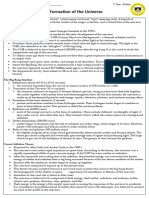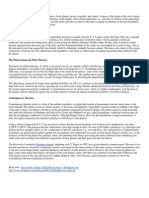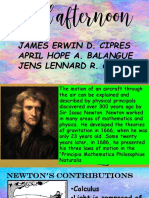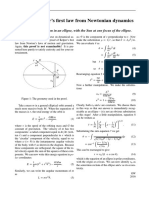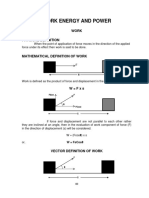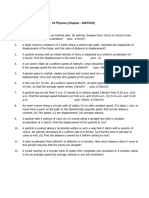Big Bang: Bad Approximation Since The Average Density of The Universe Is Extremely Low
Big Bang: Bad Approximation Since The Average Density of The Universe Is Extremely Low
Uploaded by
Uwe KlaasCopyright:
Available Formats
Big Bang: Bad Approximation Since The Average Density of The Universe Is Extremely Low
Big Bang: Bad Approximation Since The Average Density of The Universe Is Extremely Low
Uploaded by
Uwe KlaasOriginal Title
Copyright
Available Formats
Share this document
Did you find this document useful?
Is this content inappropriate?
Copyright:
Available Formats
Big Bang: Bad Approximation Since The Average Density of The Universe Is Extremely Low
Big Bang: Bad Approximation Since The Average Density of The Universe Is Extremely Low
Uploaded by
Uwe KlaasCopyright:
Available Formats
Big Bang
The overall framework of the big bang theory came out of solutions to Einstein's general relativity field equations and remains unchanged, but various details of the theory are still being modified today. Einstein himself initially believed that the universe was static. When his equations seemed to imply that the universe was expanding or contracting, Einstein added a constant term to cancel out the expansion or contraction of the universe. When the expansion of the universe was later discovered, Einstein stated that introducing this "cosmological constant" had been a mistake (his biggest blunder, grte Eselei). After Einstein's work of 1917, several scientists, including the abb Georges Lematre in Belgium, Willem de Sitter in Holland, and Alexander Friedmann in Russia, succeeded in finding solutions to Einstein's field equations. The universes described by the different solutions varied. De Sitter's model had no matter in it. This model is actually not a bad approximation since the average density of the universe is extremely low. Lematre's universe expanded from a "primeval atom." Friedmann's universe also expanded from a very dense clump of matter, but did not involve the cosmological constant. These models explained how the universe behaved shortly after its creation, but there was still no satisfactory explanation for the beginning of the universe. In the 1940s George Gamow was joined by his students Ralph Alpher and Robert Herman in working out details of Friedmann's solutions to Einstein's theory. They expanded on Gamow's idea that the universe expanded from a primordial state of matter called ylem consisting of protons, neutrons, and electrons in a sea of radiation. They theorized the universe was very hot at the time of the big bang (the point at which the universe explosively expanded from its primordial state), since elements heavier than hydrogen can be formed only at a high temperature. Alpher and Hermann predicted that radiation from the big bang should still exist. Cosmic background radiation roughly corresponding to the temperature predicted by Gamow's team was detected in the 1960s, further supporting the big bang theory, though the work of Alpher, Herman, and Gamow had been forgotten.
The Theory
The big bang theory seeks to explain what happened at or soon after the beginning of the universe. Scientists can now model the universe back to 10-43 seconds after the big bang. For the time before that moment, the classical theory of gravity is no longer adequate. Scientists are searching for a theory that merges quantum mechanics and gravity, but have not found one yet. Many scientists have hope that string theory will tie together gravity and quantum mechanics and help scientists explore further back in time. Because scientists cannot look back in time beyond that early epoch, the actual big bang is hidden from them. There is no way at present to detect the origin of the universe. Further, the big bang theory does not explain what existed before the big bang. It may be that time itself began at the big bang, so that it makes no sense to discuss what happened "before" the big bang.
According to the big bang theory, the universe expanded rapidly in its first microseconds. A single force existed at the beginning of the universe, and as the universe expanded and cooled, this force separated into those we know today: gravity, electromagnetism, the strong nuclear force, and the weak nuclear force. A theory called the electroweak theory now provides a unified explanation of electromagnetism and the weak nuclear force theory. Physicists are now searching for a grand unification theory to also incorporate the strong nuclear force. String theory seeks to incorporate the force of gravity with the other three forces. One widely accepted version of big bang theory includes the idea of inflation. In this model, the universe expanded much more rapidly at first, to about 1050 times its original size in the first 10-32 second, then slowed its expansion. The theory was advanced in the 1980s by American cosmologist Alan Guth and elaborated upon by American astronomer Paul Steinhardt, Russian American scientist Andrei Linde, and British astronomer Andreas Albrecht. The inflationary universe theory solves a number of problems of cosmology. For example, it shows that the universe now appears close to the type of flat space described by the laws of Euclid's geometry: We see only a tiny region of the original universe, similar to the way we do not notice the curvature of the earth because we see only a small part of it. The inflationary universe also shows why the universe appears so homogeneous. If the universe we observe was inflated from some small, original region, it is not surprising that it appears uniform. Once the expansion of the initial inflationary era ended, the universe continued to expand more slowly. The inflationary model predicts that the universe is on the boundary between being open and closed. If the universe is open, it will keep expanding forever, even though the rate of expansion will gradually slow. If the universe is closed, the expansion of the universe will eventually stop and the universe will begin contracting until it collapses. Whether the universe is open or closed depends on the density, or concentration of mass, in the universe. If the universe is dense enough, it is closed.
Supporting Evidence
The universe cooled as it expanded. After about one second, protons formed. In the following few minutesoften referred to as the "first three minutes," combinations of protons and neutrons formed the isotope of hydrogen known as deuterium as well as some of the other light elements, principally helium, as well as some lithium, beryllium, and boron. The study of the distribution of deuterium, helium, and the other light elements is now a major field of research. The uniformity of the helium abundance around the universe supports the big bang theory and the abundance of deuterium can be used to estimate the density of matter in the universe. From about 300,000 to about 1 million years after the big bang, the universe cooled to about 3000 C (about 5000 F) and protons and electrons combined to make hydrogen atoms. Hydrogen atoms can only absorb and emit specific colors, or wavelengths, of light. The formation of atoms allowed many other wavelengths of light, wavelengths that had been interfering with the free electrons, to travel much farther than before. This change set free radiation that we can detect today. After billions of years of cooling, this
cosmic background radiation is at about 3 K (-270 C/-454 F).The cosmic background radiation was first detected and identified in 1965 by American astrophysicists Arno Penzias and Robert Wilson. The National Aeronautics and Space Administration's Cosmic Background Explorer (COBE) spacecraft mapped the cosmic background radiation between 1989 and 1993. It verified that the distribution of intensity of the background radiation precisely matched that of matter that emits radiation because of its temperature, as predicted for the big bang theory. It also showed that the cosmic background radiation is not uniform, that it varies slightly. These variations are thought to be the seeds from which galaxies and other structures in the universe grew.
Refining the Theory
Evidence indicates that the matter that scientists detect in the universe is only a small fraction of all the matter that exists. For example, observations of the speeds with which individual galaxies move within clusters of galaxies show that there must be a great deal of unseen matter exerting gravitational forces to keep the clusters from flying apart. Cosmologists now think that much of the universe - perhaps 99 percent - is dark matter, or matter that has gravity but that we cannot see or otherwise detect. Theorized kinds of dark matter include cold dark matter, with slowly moving (cold) massive particles. No such particles have yet been detected, though astronomers have given them names like Weakly Interacting Massive Particles (WIMPs). Other cold dark matter could be nonradiating stars or planets, which are known as MACHOs (Massive Compact Halo Objects). An alternative model includes hot dark matter, where hot implies that the particles are moving very fast. The fundamental particles known as neutrinos are the prime example of hot dark matter. If the inflationary version of big bang theory is correct, then the amount of dark matter that exists is just enough to bring the universe to the boundary between open and closed. Scientists develop theoretical models to show how the universe's structures, such as clusters of galaxies, have formed. Their models invoke hot dark matter, cold dark matter, or a mixture of the two. This unseen matter would have provided the gravitational force needed to hold large structures such as clusters of galaxies together. The theories continue to match the observations, though there is no consensus on the type or types of dark matter that must be included. Supercomputers are important for making such models. Astronomers are making new observations that are interpreted within the framework of the big bang theory. Scientists have not found any major problems with the big bang theory, but the theory is being constantly adjusted to match the observed universe.
You might also like
- P10.1 Student Calculation Sheet: Force, Mass, and AccelerationDocument4 pagesP10.1 Student Calculation Sheet: Force, Mass, and AccelerationBenjamin WatsonNo ratings yet
- Big Bang TheoryDocument5 pagesBig Bang TheorytimmylovesNo ratings yet
- UniverseDocument4 pagesUniverseCarl Warren RodriguezNo ratings yet
- ReportDocument62 pagesReportSarah Shine TorresNo ratings yet
- Welcome To Earth Science!Document41 pagesWelcome To Earth Science!Rissabelle Cosca100% (1)
- Theories About The Origin of The UniverseDocument6 pagesTheories About The Origin of The UniverseelenaponcehernaizNo ratings yet
- How The Earth Was CreatedDocument2 pagesHow The Earth Was Createdniradiasih41No ratings yet
- Big Bang Theory: The-Origin-Of-The-UniverseDocument33 pagesBig Bang Theory: The-Origin-Of-The-UniverseMayank Kumar LodhiNo ratings yet
- Ias 1Document6 pagesIas 1Muid XaikatNo ratings yet
- SHS Math and Science Instructor STI College San Pablo: (Current Accepted Model On The Formation of The Universe)Document9 pagesSHS Math and Science Instructor STI College San Pablo: (Current Accepted Model On The Formation of The Universe)Emman RevillaNo ratings yet
- Origins of The UniverseDocument1 pageOrigins of The UniverseGerryNo ratings yet
- Earth Science Lesson 1Document77 pagesEarth Science Lesson 1Joie mae100% (1)
- PHYSICAL SCIENCE Module 1Document23 pagesPHYSICAL SCIENCE Module 1April Joy PatricioNo ratings yet
- Lesson 1 Big Bang Theory PDFDocument12 pagesLesson 1 Big Bang Theory PDFMarianne TolentinoNo ratings yet
- Hypothesis On The Origin of The Universe and The Solar SystemDocument45 pagesHypothesis On The Origin of The Universe and The Solar SystemMichael Angelo VillaruelNo ratings yet
- Earth Sci NotesDocument170 pagesEarth Sci NotesErekha Jicah Sheibe SayonNo ratings yet
- A.D. End of UniverseDocument3 pagesA.D. End of UniverseHanef AlinorNo ratings yet
- Mod1 - Formation of The UniverseDocument2 pagesMod1 - Formation of The Universekathloquellano08No ratings yet
- Hyphothesis On The Beginning of The UniverseDocument41 pagesHyphothesis On The Beginning of The Universeradzma moralesNo ratings yet
- What Is The Big Bang TheoryDocument2 pagesWhat Is The Big Bang Theorystealth solutionsNo ratings yet
- The Origin of The UniverseDocument22 pagesThe Origin of The UniverseamerofficialyNo ratings yet
- Lecture NotesDocument92 pagesLecture NotesSharyl Plan SarominesNo ratings yet
- Els Lesson.Document3 pagesEls Lesson.Tazanna RenovetteNo ratings yet
- Earth and Life Sciences Quarter 1Document73 pagesEarth and Life Sciences Quarter 1Arr FernandezNo ratings yet
- Big Bang Theory - Geography NotesDocument3 pagesBig Bang Theory - Geography NotesChahat PandeyNo ratings yet
- 1 EaLS Formation of The Earth 021303Document20 pages1 EaLS Formation of The Earth 021303Kyla AyongNo ratings yet
- Vertinity of PlanetDocument6 pagesVertinity of PlanetFarwa ArshadNo ratings yet
- The Theory of The Big BangDocument4 pagesThe Theory of The Big Bangcarlrodrigo001No ratings yet
- RegenerateDocument1 pageRegenerateAkiesha ScottNo ratings yet
- Origin of UniverseDocument10 pagesOrigin of UniverseEmmanuel de LeonNo ratings yet
- Week 1 Day 1 Module Physical ScienceDocument3 pagesWeek 1 Day 1 Module Physical ScienceEunice Acuna100% (1)
- Origin UniverseDocument48 pagesOrigin UniverseJerielita MartirezNo ratings yet
- Chapter 1 - Earth ScienceDocument6 pagesChapter 1 - Earth ScienceBierzo JomarNo ratings yet
- Big Bang TheoryDocument6 pagesBig Bang TheorySharreah LimNo ratings yet
- Chapter 1 Origin of The Universe (Summary)Document2 pagesChapter 1 Origin of The Universe (Summary)Amstrada Guieb Palomo-TinteNo ratings yet
- Origin of The UniverseDocument5 pagesOrigin of The UniverseMaristela EspinaNo ratings yet
- Earth ScienceDocument149 pagesEarth SciencesaintEmNo ratings yet
- Origins of The Universe 101Document5 pagesOrigins of The Universe 101Phil BinongoNo ratings yet
- The Origin of The Universe and The Solar SystemDocument7 pagesThe Origin of The Universe and The Solar SystemThea Aaliyah Cruz ShalimNo ratings yet
- The Big Bang Theory Summary NoteDocument2 pagesThe Big Bang Theory Summary NoteNath ReyesNo ratings yet
- Origins of The TheoryDocument32 pagesOrigins of The TheoryMaria Flor PabeloniaNo ratings yet
- 1.origin and Structure of The EarthDocument9 pages1.origin and Structure of The EarthAshley Joy Delos ReyesNo ratings yet
- Lesson 1 Big Bang TheoryDocument36 pagesLesson 1 Big Bang TheoryEthan LopezNo ratings yet
- Steady State TheoryDocument7 pagesSteady State TheoryLenz BautistaNo ratings yet
- Universe and It'S OriginDocument25 pagesUniverse and It'S OriginRoceline AtienzaNo ratings yet
- Origins of The Universe 101Document3 pagesOrigins of The Universe 101Sandra Silva-Montero100% (1)
- History of Study: Timeline of Cosmology List of CosmologistsDocument7 pagesHistory of Study: Timeline of Cosmology List of CosmologistsnieotyagiNo ratings yet
- Elsice ReviewerDocument28 pagesElsice ReviewerJacquesse Mackenzie LicoNo ratings yet
- Origin of The Solar SystemDocument3 pagesOrigin of The Solar System.Mikey.OrangeMurderbyChocolate.No ratings yet
- Big Bang TheoryDocument29 pagesBig Bang TheoryNo NameNo ratings yet
- List Down Five Theories About The Origin of The UniverseDocument4 pagesList Down Five Theories About The Origin of The UniverseZymon FernandezNo ratings yet
- Earth Science Lesson 1Document30 pagesEarth Science Lesson 1Frances Marinnelle EstrellanNo ratings yet
- Big BangDocument22 pagesBig BangZoltán GesterNo ratings yet
- The Evolution of The UniverseDocument32 pagesThe Evolution of The UniverseTorrentAreaNo ratings yet
- New Scientist - The Cosmos - Before The Big BangDocument7 pagesNew Scientist - The Cosmos - Before The Big BangHuntsmithNo ratings yet
- Big Bang Theory PresentationDocument7 pagesBig Bang Theory Presentationaadn787No ratings yet
- The Beginning of The Universe: Halley's CometDocument3 pagesThe Beginning of The Universe: Halley's CometdfrostubaNo ratings yet
- Week 1 - 2Document98 pagesWeek 1 - 2ysabellamacahiyaNo ratings yet
- AsiaDocument4 pagesAsiaRemigiusz GolanowskiNo ratings yet
- The Physical Concept of The DerivativeDocument5 pagesThe Physical Concept of The DerivativenavisinghNo ratings yet
- Rectangular and Polar CoordinatesDocument3 pagesRectangular and Polar CoordinatesMark Baguia DandoyNo ratings yet
- Aptitude Clocks PDFDocument7 pagesAptitude Clocks PDFjayanthNo ratings yet
- Gravitation (QB) WA 12thDocument16 pagesGravitation (QB) WA 12thRaju SinghNo ratings yet
- Cheat Sheet AOS 3Document1 pageCheat Sheet AOS 3Samana GulzariNo ratings yet
- 3191531Document16 pages3191531LUIS ISAAC LEON PARONo ratings yet
- Emlectures 2Document87 pagesEmlectures 2Abc GoogleNo ratings yet
- Suppose You FinDocument5 pagesSuppose You FinJohn Kevin Noche100% (1)
- Module II: Relativity and Electrodynamics: Lecture 4: Covariant and Contravariant 4-VectorsDocument19 pagesModule II: Relativity and Electrodynamics: Lecture 4: Covariant and Contravariant 4-Vectorsanandh_cdmNo ratings yet
- Chap. Speed Distance TimeDocument20 pagesChap. Speed Distance TimebinzakerzawadNo ratings yet
- Add Math Form 5 Integration Collection of Trial SPM Questions 2012 Paper 2Document6 pagesAdd Math Form 5 Integration Collection of Trial SPM Questions 2012 Paper 2Eric Wong100% (1)
- 09 Science Motion Test 02Document2 pages09 Science Motion Test 02sur_esh16octNo ratings yet
- P 101 TB 1 QDocument27 pagesP 101 TB 1 QmakNo ratings yet
- Rotational Equations of MotionDocument2 pagesRotational Equations of Motionjohn mesNo ratings yet
- First Law of MotionDocument25 pagesFirst Law of MotionErwin CipresNo ratings yet
- Proof of Kepler's First Law From Newtonian DynamicsDocument1 pageProof of Kepler's First Law From Newtonian DynamicsKuligovski LeonardoNo ratings yet
- Practice Test ch-01 2Document7 pagesPractice Test ch-01 2api-301275445No ratings yet
- Problemas Resueltos Estatica EquilibrioDocument2 pagesProblemas Resueltos Estatica EquilibriopabloNo ratings yet
- Portfolio Example 1 - May The Force Be With YouDocument2 pagesPortfolio Example 1 - May The Force Be With Youapi-359354696No ratings yet
- Ch.9 Constant AccelerationDocument1 pageCh.9 Constant AccelerationangelinatianranNo ratings yet
- Physics Lab 1 10-7 NolDocument4 pagesPhysics Lab 1 10-7 Nolapi-257035141No ratings yet
- The Mind of Albert Einstein A Glimpse Into GeniusDocument2 pagesThe Mind of Albert Einstein A Glimpse Into GeniusWesley TashiyaNo ratings yet
- How To Tell The Time PDFDocument1 pageHow To Tell The Time PDFYolanda GBNo ratings yet
- Time ZoneDocument16 pagesTime ZoneJobins KjNo ratings yet
- Application of Circular MotionDocument13 pagesApplication of Circular MotionChi KoyNo ratings yet
- Gravitational Memory Effects in Chern-SimonsDocument22 pagesGravitational Memory Effects in Chern-SimonsThiago BergamaschiNo ratings yet
- Work, Energy and Power - Lecture Notes and Practice QuestionsDocument24 pagesWork, Energy and Power - Lecture Notes and Practice Questionszehra giyori100% (1)
- Class 9 Motion TestDocument2 pagesClass 9 Motion TestANUJ KALRANo ratings yet


















